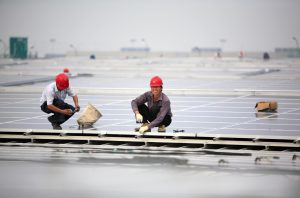The slowdown in China's economy is increasingly reflected in the country's flatlining power demand, a move that could deliver clear environmental benefits through a fall in coal consumption and increased use of renewable energy.
According to the latest figures released by National Bureau of Statistics (NBS), China generated a little over 5.6 trillion kilowatt-hours of electricity in 2015, down 0.2% from the previous year – its first drop since 1968.
Electricity output is an important gauge of the vitality of the industrial sector, and is a major cause of pollution in China, where coal is used for around two-thirds of power generation. Much of this electricity is used by heavy industries such as cement, steel, chemicals, materials and metals production.
Not only is coal-fired power generation blamed in part for the country's chronic air quality, the fuel is the biggest single source of greenhouse gas emissions in China, the world's largest emitter of carbon dioxide.
Since China’s GDP fell to an annual rate of 6.9%, its slowest pace in 25 years, electricity suppliers have been forced to rein in production and adapt to less favourable market conditions.
“From the data, we can see that China’s economy is still in the process of transition," said Wang Tao, assistant dean of the China Business News Research Institute. Total energy consumption, which includes oil products used in transport, only grew by 0.9% in 2015, the lowest growth rate since 1998, Wang added.
The same downward trend has affected China’s electricity consumption. The National Energy Administration confirmed that power consumption in 2015 stood at 5.55 trillion kilowatt-hours, an increase of only 0.5% year-on-year. The figure is 3.3% less than the 2014 level, registering as the slowest growth since 1974.
Zhou Dadi, a senior research fellow with the Energy Research Institute of the National Development and Reform Commission, said that weakening demand from the industrial sector had contributed most to the decline.
“A ‘new normal’ has been unfolding in China’s power sector. It’s marked by weakening demand and a contraction in output resulting from the industrial restructuring. We have been used to seeing annual electricity consumption increase by 8% or more but it’s quite a different situation now,” said Zhou.
New players
Meanwhile, coal’s contribution to the energy mix has continued to fall since its initial drop in 2014. Last year, electricity generated from thermal power (which includes gas) fell by 2.8%.
“This trend originates from an overall weakening demand and the increasing contribution of non-fossil fuels,” said Wang.
By contrast, 2015 saw a 20% increase in the contribution of non-fossil fuels and renewables to electricity output, further evidence that China's fast-growing renewable energy sector is speeding up its shift away from coal, said Li Junfeng, director general of the National Climate Change Strategy Research and International Cooperation Center.
Long-term trend
“The deployment of more non-fossil fuels will not only meet electricity demand, but will eventually substitute the share that coal-fired power plants used to provide. In coming years, thermal powered electricity output is expected to decline at an annual rate of 2%-4%. In the meantime, the contribution of non-fossil fuels will increase by more than 20 % annually,” Li added. "The decline [in power demand] will be a long-term trend.”
However, despite the decline in output, more coal-fired plants were installed last year even though these are expected to become less economically efficient in future years, as renewable energy is given preferential access to the grid.
“Some local governments are still purchasing and installing new coal-fired generation units. This activity is clearly a misconception of the overall [oversupply] situation and should be curbed vigorously,” said the ERI's Zhou.
Renewables power up
Analysts estimate that renewable energy, including hydro and nuclear will account for 1.7 trillion kilowatt-hours in 2016. Increases in wind and photovoltaic solar capacity will become the main focus of China's push for cleaner energy.
Alvin Lin, China climate and energy policy project director from the Natural Resource Defense Council, noted that China’s energy sector, and wider economy, are moving decisively away from coal.
“With continuing efforts to reduce air pollution and carbon emissions, 2016 is likely to be a crucial year for China to cap coal consumption and restructure its economy in a more sustainable manner.”
More efficient and wider deployment of non-fossil fuels and renewables could have wide economic benefits, said a recent report by the International Renewable Energy Agency.
Economic benefits
The report predicts that the global GDP can increase by up to 1.1% in 2030 if the share of renewables in the global energy mix can be doubled to reach 36% by that time. In economic terms, the GDP increase would be worth US$1.3 trillion (8.3 trillion yuan), in which China would have a large share.
According to the agency, China is already home to the world’s largest workforce for renewables-related industries. More than 3.4 million people are employed in the sector, with more than half of them concentrated on the solar photovoltaics sector.
With more investments and technological upgrades in the offing, these industries are expected to diversify further and serve as an alternative, healthier and greener lubricant for China’s economic engine.
With contributions from Yu Jie and Monica Wang






